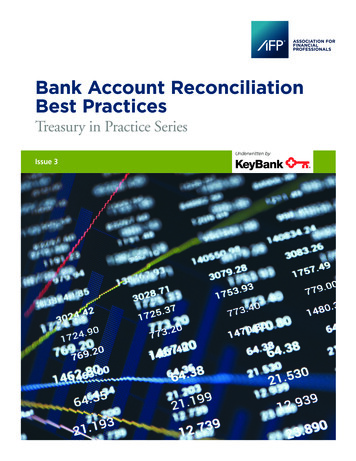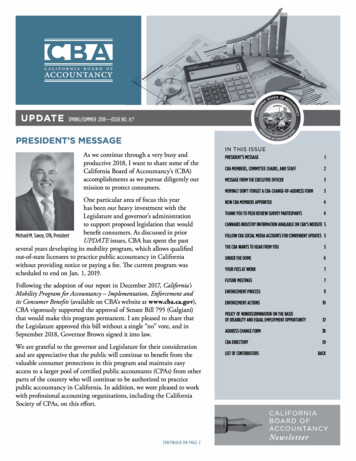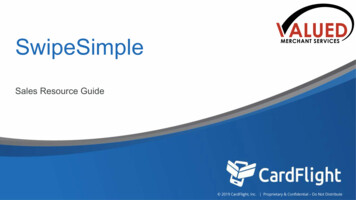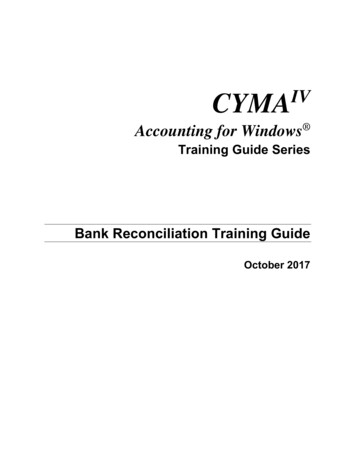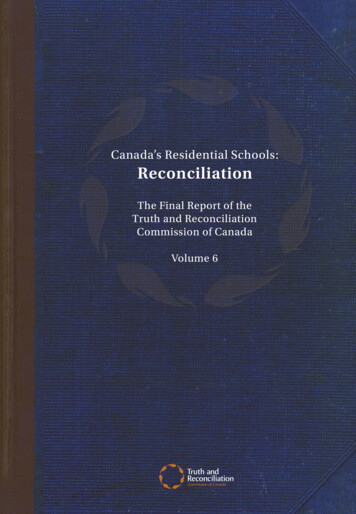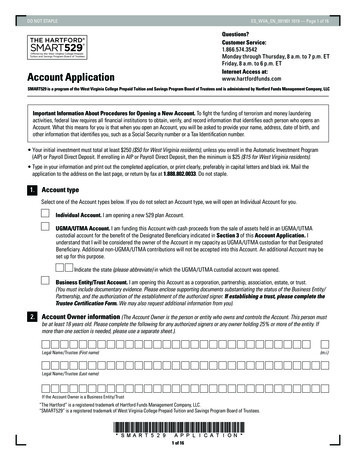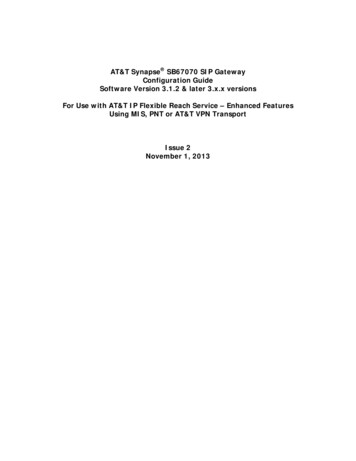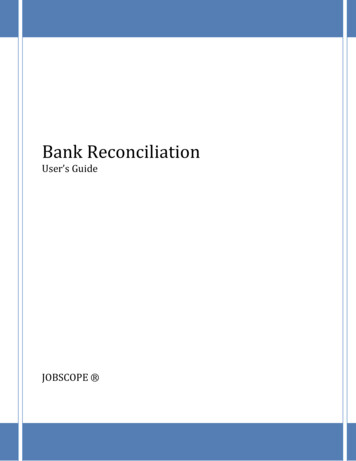
Transcription
MANUALCentrally Billed Account (CBA)Reconciliation ManualMarch 01, 2022v5.5Department of Defense Defense Human Resources Activity
CBA Reconciliation ManualMarch 01, 2022Table of ContentsRevision History . 4Chapter 1: Introduction . 5Chapter 2: Pre-Implementation Considerations . 62.1 TMC Processing .62.2 Traveler Behavior .62.3 Authorizing Official Behavior .72.4 CBA-Specialist Selection .72.5 Financial Considerations .72.6 Site Fielding and Implementation .82.7 Additional Training Resources.9Chapter 3: Overview . 113.1 Roles and Responsibilities .113.1.1 CBA Administrator .113.1.2 CBA DTA .123.1.3 CBA Specialist.133.2 Process Overview.153.3 Access to the CBA Tool.16Chapter 4: Auto-Reconciliation . 174.1 Auto-Reconciliation Overview.174.1.1 Transaction Statuses.184.1.2 Transaction Classifications.194.2 Matching Criteria .21Chapter 5: Manual Reconciliation . 235.1 Review Transactions .235.1.1 Select an Invoice to Review .235.1.2 View Transactions on the Selected Invoice .275.1.3 View Details of a Single Transaction .285.2 Unmatched Transactions: Cures for Various Causes .295.2.1 Amendments .315.2.2 Manual Advance Credit .355.2.3 Reconcile Transactions .365.2.4 Held Transactions .385.2.5 Dispute a Transaction .405.2.6 PPA Interest and Interest Transactions .44Defense Travel Management Office1
CBA Reconciliation ManualMarch 01, 2022Chapter 6: Acknowledgement and Certification . 476.1 Acknowledge an Invoice .476.2 Certify an Invoice .486.3 Carried Over Invoices .506.4 Rejected Invoices .516.5 Original CCV and Interim Invoices .516.6 Invoice Statuses .52Chapter 7: Credit Transactions . 547.1 Suspended Transactions .547.2 Unmatched Refunds .567.3 Consolidated Transactions .577.3.1 Netted Debits.577.3.2 Wash Debits and Wash Credits .587.4 Advanced Credits and Previously Applied Credits .597.4.1 Manual Advanced Credits and Manual Previously Applied Credits .597.4.2 Warnings About Advanced Credits and Manual Advanced Credits .607.5 Unmatched Refunds – Airline Credits .607.6 Credits Not Received.61Chapter 8: CBA DTA . 628.1 Access the CBA DTA Module.628.2 CBA Management .628.2.1 Search for a CBA .638.2.2 Edit a CBA .648.2.3 Delete a CBA.658.2.4 Add a New (i.e., Create a) CBA .658.2.5 Assign a Default CBA .70Chapter 9: Compliance Report . 72Chapter 10: Read Only Access (ROA) . 7410.1 ROA Roles and Administration .7410.2 View Invoices Using ROA.7410.2.1 Invoice Summary.7510.2.2 Transaction Summary .7610.2.3 Transaction Detail .7610.3 View Trip Data Using ROA .77Appendix A: CBA Tool Email Notifications . 80Appendix B: Definitions . 87Appendix C: Frequently Asked Questions (FAQs). 91Defense Travel Management Office2
CBA Reconciliation ManualMarch 01, 2022Appendix D: Troubleshooting . 93D.1 Suggested Corrective Actions.93D.2 Suspended, Held, or Disputed Transactions .103D.3 Matched Transactions.104Appendix E: CBA DTA Desk Reference . 105E.1 Enter Account Information into the DTS CBA Tool .105E.2 Default Account for the Organization .107Appendix F: CBA-S Desk Reference . 109F.1 DTS Travel Arrangements Process Flow .109F.2 The Effect of Cancelled Authorizations on CBA Reconciliation .110F.3 DTS CBA Reconciliation Process .110F.3.1 Processing Order .111F.3.2 Invoice Is Not Received .111F.3.3 Summary Points .111F.4 DTS CBA Tool Matching Criteria.111F.5 Common Causes of Unmatched Transactions and Their Fixes .112F.6 Amendments .113F.7 Credit Transactions .115F.7.1 Suspended Transactions .115F.7.2 Wash Debit, Wash Credit, and Netted Debit Transactions .115F.7.3 Advance Credit and Previously Applied Credit Transactions .115F.7.4 Unmatched Refund (Credit) Transactions .116F.7.5 Airport Credit Transactions .116F.8 Held Transactions and Interim Invoices .116F.9 Transactions with an All-Zero Ticket Number .116F.10 Disputed and Closed Transactions .117F.11 Acknowledgement and Certification of Invoices .118F.12 ROA Invoices Tool .118F.13 Emails.119F.14 Rejects .119F.15 Additional CBA Information .120Defense Travel Management Office3
CBA Reconciliation ManualMarch 01, 2022Revision HistoryRevisionNo.DateAuthorizationRevision/Change DescriptionChapter3.3.1409/05/2008Defense TravelManagementOffice (DTMO)Updated text/screen shots fornew Credits Not Received andView Organization Report3.3.1512/20/2008DTMOUpdated text/screen shots forRelease 1.7.14Throughout4.005/01/2016DTMORewrite of complete manualAll chaptersandappendicesDTMOGeneral scrub for readability andredundancy reductionAll chaptersandappendicesSection8.2.4Section 10.35.009/26/20185.101/04/2019DTMOAdded comment about the DAIaccounting system’s limitationsUpdated ROA Trip screens5.211/07/2019DTMOLink updatesGeneral reviewAll chaptersandappendicesPage 9,Page 99,Page 87,Page 88 andPage 1155.306/18/20DTMOLink updatesUpdated screen shotsUpdated text5.402/12/21DTMOUpdated Message Center screenshotsGeneral reviewChapter 3,8, and 10Throughout5.503/01/22DTMORebranding effortAllDefense Travel Management Office4
CBA Reconciliation ManualMarch 01, 2022Chapter 1: IntroductionTravelers use DTS to procure airline and rail reservations to go on official travel. Those who do not have theirown Government Travel Charge Card (GTCC) may use their organization’s Centrally Billed Account (CBA) to payfor those reservations. Just like an ordinary GTCC, the charge card vendor (CCV) sends a monthly invoice thatlists the charges made against the CBA. The DTS Reconciliation process starts with an automated attempt tomatch the charges on the CCV’s monthly invoice against DTS travel documents. If necessary, a manual attemptto match the remaining transactions follows. Once the steps are complete, the invoice is acknowledged andcertified for payment.This manual provides guidance to the various personnel who use the CBA Tool, to help them perform theirduties. Table 1-1 outlines information covered in this manual: the CBA Process, the CBA Reconciliation process,and the key roles in those processes.Table 1-1In this manual, unless otherwise noted, “you” refers to a CBA Specialist (CBA-S. 2. This document is a resourceguide and is not an official DoD regulation. Personnel should consult official DoD regulations – i.e., DoD GTCCRegulations, the Joint Travel Regulations (JTR), and component-specific regulations to ensure compliance.Defense Travel Management Office5
CBA Reconciliation ManualMarch 01, 2022Chapter 2: Pre-Implementation ConsiderationsFor this chapter, “you” are the person responsible for evaluating your site’s ability to implement and successfullyuse the DTS CBA Reconciliation module.You must take certain steps before an organization can use the CBA Tool. First, evaluate the organization todetermine if it can successfully use the CBA Tool. Failing to take this first step may lead to an unsuccessfulimplementation of or long-term difficulties with CBA reconciliation. You can evaluate your site’s potential forsuccess by reviewing their business processes in a few key areas.2.1 TMC ProcessingEnsure the site’s local business rules and the Travel Management Company (TMC) contract address therequirement to return ticketed Passenger Name Records (PNRs) in DTS travel documents. This action must populate at least one ticket number and all applicable TMC fees in the authorization.Review all of the organization’s recent CCV invoices that are being reconciled outside of DTS. Determine therough success rate in matching CCV invoice transactions against DTS authorizations. What percentage matchedboth ticket number and cost? The lower the percentage of matches, the lower the odds that the organization is a good candidate forimplementing the CBA Tool. If the ticketed number and cost do not regularly match, DTS will not be able to auto-match thetransactions either. This will lead to a higher need for document amendments, extra work for your CBASpecialists, and delayed payments to the CCV.2.2 Traveler BehaviorReview recent travel authorizations and traveler profiles. Do travelers understand DoD travel policy andorganization business rules related to DTS and CBA use? Do they follow it? Do they use the DTS Reservationsmodule and keep their DTS profiles current? The more the travelers use the DTS Reservations module and keep their DTS profiles up to date thebetter the odds that the organization is a candidate for successful implementation. Consider the extentto which:oTravelers use the DTS Reservations module to make travel arrangements, including using theTMC Assistance options when they cannot find specific flights, lodging, etc.oThe IBA account numbers and expirations dates in travelers’ DTS profiles are up to date. Howquickly they update their profile when they receive a new IBA account number or expirationdate.oWhether Defense Travel Administrators (DTAs) work closely with Agency ProgramCoordinators (APCs) to help maintain traveler IBA data. To minimize CBA use, a DTA shouldregularly run the Accounts Info List report (Figure 2-1) to: Identify the current IBA details in travelers’ DTS profiles. Compare those details to cardholders’ IBA account data the APC provides. Update the IBA info in travelers’ DTS profiles or notify the travelers to do it.Defense Travel Management Office6
CBA Reconciliation ManualMarch 01, 2022Figure 2-1: Accounts Info List Report2.3 Authorizing Official BehaviorDo the Authorizing Officials (AOs) understand the organization’s policy and local business rules related to CBAuse? The higher the percentage of AOs who perform the following tasks correctly, the better candidate theorganization is for successful CBA implementation: Understand and enforce the organization’s business rules, especially in regards to CBA use through thedocument approval process (i.e. discouraging CBA use for IBA cardholders). The organization must havea well-defined CBA use policy; if it does not, then you should address the issue with your senior leaders. Approve travel documents in a timely manner. A DTA can run the DTS Approved Status report tovalidate this information. The CBA Tool cannot match transactions in unapproved travel documents.2.4 CBA-Specialist SelectionSelection of the right personnel to reconcile CBA accounts is crucial. Selected individuals must: Know how to find ticket and TMC Fee information in a DTS travel document. Be able to determine the routing status of a DTS document. Be able to correct ticket information in travel documents for LOA rejects.oReceive training on how to use the CBA Tool before implementation.2.5 Financial ConsiderationsAt OCONUS locations, check the TMC contact to determine whether the TMC issues tickets using foreigncurrency or U.S. dollars. If your TMC issues tickets using foreign currency, your site IS NOT a candidate as DTS cannot processtransactions subject to foreign currency fluctuation.oThis issue is specific to receiving refunds for matched and paid debits. For example, in June,the CBA-S matches and pays a debit, after currency conversion, of 100. In July, the TMCissues a refund, after currency conversion, of 110. DTS cannot process the refund, because itis not the same cost as the original obligated and disbursed debit.If your organization does not process obligations through DTS, your site CANNOT use the CBA Tool. If anobligation does not exist in DTS, you cannot process a disbursement through DTS.Defense Travel Management Office7
CBA Reconciliation ManualMarch 01, 20222.6 Site Fielding and ImplementationAfter you evaluate your business processes and decide to implement and use the CBA Tool, there are severalsteps to take before you receive your first CCV invoice in the CBA Tool.Use the following checklist to ensure you complete and coordinate all necessary actions. Note: Not all steps areyours to complete, but you must ensure the responsible party accomplishes the required action before CBAimplementation. Complete and process a CBA application with Citi. The URL t-Setup-Application.pdfo Select 461427 as the account classification in Section 1.16 – this number sequence is uniquefor each CBA.Modify TMC contracts to reflect that:oPaper authorizations are not required for CBA purchases.oCBA reconciliation will begin on date . After that date, the TMC no longer needs to provideCBA reconciliation assistance. Note: Each TMC contract is unique, so this notification mustinclude particulars about the support that the TMC used to provide for CBA reconciliation.Select, train, and officially appoint each CBA-S.oSelect CBA-Ss. Each must understand the reconciliation process. People from the Finance andTransportation teams often make good choices. This is a key role. Wise decisions improveyour chances of success.oTrain CBA-Ss. The scope of required training depends directly on each person’s current levelof CBA and DTS experience.oAppoint each CBA-S as a Certifying Officer on a DD Form 577 after verifying that the CBA-Ssuccessfully completed an approved Certifying Officer Legislation (COL) training class.oUpdate each CBA-S’s DTS permission levels and accesses. A CBA-S requires (at least)permission level 4 and organization access to the organizations they will support. Register with the TAC.o Update any additional GTCC systems used to process Statement and Paymentinquiries (e.g., CitiManager).Ensure each CBA-S knows how to open and track help desk tickets.Modify site business rules to state that:oTravelers must: Use DTS and the Reservations module. Update ticket costs as necessary. Include ticket numbers vs. use of See Attached Ticket as a generic ticket numberwhen entering ticket information in DTS.Defense Travel Management Office8
CBA Reconciliation Manual Process travel documents in a timely manner to avoid delays with matching tickets in theCBA ToolAOs must:oEnforce your Component’s CBA policy.oProcess CBA travel documents in DTS as quickly as possible.CBA-Ss must:o March 01, 2022Communicate their role so that travelers, AOs, and DTAs understand the support they needand why.DTAs:oInsert a conditional Travel Mode Route step on appropriate routing lists to ensure that a CBAS sees all travel documents that use CBA as a form of payment. This helps ensure proper CBAuse, as the CBA-S can return documents that inappropriately used a CBA, so the traveler canupdate the method of payment, allowing the TMC to charge the correct account.oCreate a special CBA routing list to use on vouchers amended solely to match a CBAtransaction. A CBA-S, functioning as a Non-DTS Entry Agent [NDEA]) stamps the document TENTERED to route it directly to a person who will approve the amendment.CBA DTAs notify DFAS Vendor Pay points of contact to inform them that the organization will beprocessing CBAs. The information they must provide to DFAS Vendor Pay includes: DTS Central Account Number CBA-Ss’ names, email addresses, and phone numbersNote: Some Vendor Pay systems (e.g., GFEBS, DAI, CAPSW), require this step as part of Pre-Validation.Failure to accomplish it could result in rejected CCV invoices and payment delays. You must contact yourVendor Pay POC to determine if notification of account setup is required. Complete and submit the CBA Load Worksheet - download from:https://www.defensetravel.dod.mil/Docs/CBA Account Load Worksheet.pdf Assign up to five people to each CBA account. Note: Due to the probability that you will needassistance from the TAC at some point, we recommend you assign no more than four, so a TACanalyst can be added to the account as needed. Email the completed form to the Component POCs identified on the Worksheet. Confirm that the CBA DTA processed the Worksheet.After the checklist is complete, you will start receiving monthly CCV invoices into DTS.2.7 Additional Training ResourcesThe DTMO website located at https://www.defensetravel.dod.mil/index.cfm provides a vast array of resourcesto assist in using the system and locate answers to DTS questions.You can access the following manuals and resources from the DTMO website:Defense Travel Management Office9
CBA Reconciliation ManualMarch 01, 2022 Guides, information papers, and tri-folds. Provide procedures on a wide variety of many specific topics.A key item for you is the Introduction to CBA Reconciliation in DTS information paper. You can access itdirectly at: https://www.defensetravel.dod.mil/Docs/Intro to CBA Reconciliation.pdf. Defense Travel Administrator’s (DTA) Manual. This manual includes 12 chapters and 13 appendicescovering the DTA administrative functions related to DTS setup and maintenance, electronic documentprocessing, budget setup, and reports. The Defense Travel System Guides. These five guides describe document processing in DTS: a generalintroduction, and one for each DTS document type (authorizations, vouchers, local vouchers, and groupauthorizations). The CBA Reconciliation Manual. This guide provides information on the procedures for performing CBAReconciliation functions within DTS, focusing on site CBA Specialist DTS reconciliation procedures. Thecontent includes an introduction to the CBA billing process and user functions, and the roles for CBASpecialists, CBA-DTAs, and CBA Administrators. The DTMO DTS CBA Reconciliation website. The website contains links, documents, and contactinformation to support DTS CBA reconciled accounts https://www.defensetravel.dod.mil/site/cba.cfm.You can also access training material from the DoD Travel Training and Resource Center cfm. In the Training Resource Lookup Tool, select CBA-S or DTAon the Role drop down list and then select Submit.You should always be familiar with the: Joint Travel Regulations: fm DTS Regulations, authorized by DoDI 5154.31, Volume ns/DTS.pdf GTCC Regulations, authorized by DoDI 5154.31, Volume ns/GTCC.pdfDefense Travel Management Office10
CBA Reconciliation ManualMarch 01, 2022Chapter 3: OverviewDTS provides and end-to-end process in DTS for the receipt, reconciliation, and payment of CCV invoices. TheCBA Tool allows a CBA-S to reconcile (or match) CBA payments made through DTS travel documents againstthose that appear on a CCV invoice. DTS automatically matches as many transactions as it can. It is up to theCBA-S to manually reconcile any remaining transactions.Travelers use CBA to pay for transportation charges – usually airline tickets, rail tickets, or TMC fees.Transactions may also include full or partial credits created by refunds and cancellations.Once all transactions match in the CBA Tool (or are otherwise resolved), the CBA-S acknowledges the CCVinvoice and certifies it for payment. DTS also facilitates the certification and payment process.The CBA Tool also maintains a searchable database of invoices, tracks the progress of the reconciliation process,and generates efficiency reports.This chapter reviews the CBA reconciliation and payment process, and defines the roles and responsibilities ofthose responsible for CBA reconciliation.3.1 Roles and ResponsibilitiesThis section discusses the three CBA roles in DTS, which Figure 3-1 summarizes.Figure 3-1: DTS CBA Roles3.1.1 CBA AdministratorThe CBA Administrator: Is located at the DTMO. Has functional oversight for CBA Reconciliation DoD-wide. Adds and removes CBA DTA access to the DTS CBA Tool. Rejects and restages CCV invoices. Runs reports to monitor Post-Payment Act compliance. Provides guidance to Service CBA DTAs. Acts as a CBA DTA for Defense Agencies and Joint Commands.Defense Travel Management Office11
CBA Reconciliation ManualMarch 01, 20223.1.2 CBA DTAA CBA DTA: Is located at the Component level. Creates and manages CBA accounts and processes for their Component. Creates, edits, deactivates, and deletes CBA accounts in DTS. Assigns accounts to organizations. Gives and revokes CBA-S access to accounts. Updates traveler GTCC information. Manages and supports CBA-S activities. Provides help desk support for CBA-Ss. Monitors and updates CBA account information in travelers’ DTS profiles. Works with APCs to monitor CBA delinquencies. Requests access to the DTS CBA Tool via a TAC help ticket in TraX.Note: CBA DTA contact information is available at: Eligibility Requirements: May be a military member, civilian employee, or DoD contractor. Is not an accountable official Does not have any DoD-level regulatory requirements, al
Just like an ordinary GTCC, the charge card vendor (CCV) sends a monthly invoice that lists the charges made against the CBA. The DTS Reconciliation process starts with an automated attempt to
